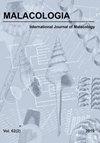软体动物,头足纲,棘足动物科棘足动物的孵化工具
IF 1
4区 生物学
Q4 ZOOLOGY
引用次数: 2
摘要
胚胎由卵孵化是胚胎发育的关键阶段。这是决定动物是否能够出现并生存下来的时刻,或者它是否会被困住而死亡。头足类动物通常在一种被称为霍伊尔器官的腺体系统中产生酶,这种酶会削弱绒毛膜,使其能够孵化。除了这种化学方法,四种头足类动物还发育了末端脊椎,以进一步支持孵化过程。这种脊椎的存在已经提到了著名的头足类动物Euprymna scolopes。然而,人们对它的结构和细胞细节知之甚少。我们目前的结果表明脊柱完全由肌肉组织组成,没有观察到中间结缔组织。脊柱内未见神经,但周围上皮和真皮肌层内存在神经纤维,提示脊柱拉伸受真皮肌组织控制。我们的数据表明,真核动物的脊椎在其组成上与其他三个进化出脊椎的头足类动物相似。然而,我们发现脊柱尖端和位于脊柱和正常上皮之间的胶原层的形态学差异。目前还不清楚为什么两个完全不同但协同的孵化系统,腺状霍伊尔器官和脊椎,存在于一些,而不是所有的头足类动物中。本文章由计算机程序翻译,如有差异,请以英文原文为准。
Spine Formation as a Hatching Tool in Euprymna scolopes (Mollusca, Cephalopoda, Sepiolidae)
ABSTRACT The hatching of an embryo from its egg is a crucial point in its development. This is the moment that decides whether the animal will be able to emerge and survive or whether it will remain trapped and die. Cephalopods usually produce enzymes in a system of glands known as the Hoyle organ, which weakens the chorion and enables hatching. In addition to this chemical approach, four cephalopod genera develop a terminal spine to further support the hatching process. The presence of such a spine has been mentioned for the well-known cephalopod species Euprymna scolopes. However, little is known about either its structure or its cellular details. Our present results indicate that the spine consists purely of musculature, and no intermediate connective tissue was observed. No nerves were detected within the spine, although nerve fibers are present within the surrounding epithelium and dermal muscle layer, indicating that the spine stretching is controlled by this dermal musculature. Our data show that the spine of Euprymna is similar in its composition to those of the other three cephalopod genera in which a spine has evolved. However, we found morphological differences in the spine tip and in a collagenous layer located between the spine and the normal epithelium. It remains unclear why two completely different but synergetic systems for hatching, the glandular Hoyle organ and a spine, exist in some, but not all, cephalopod genera.
求助全文
通过发布文献求助,成功后即可免费获取论文全文。
去求助
来源期刊

Malacologia
生物-动物学
CiteScore
2.00
自引率
0.00%
发文量
15
审稿时长
3 months
期刊介绍:
Malacologia publishes papers on all groups of the Mollusca. Malacologia specializes in publishing long papers and monographic treatments. Complete data are especially appreciated. Papers must be of interest to an international readership. Papers in systematics, ecology, population ecology, genetics, molecular genetics, evolution and phylogenetic treatments are especially welcomed. Also welcomed are letters to the editor involving papers published or issues of import to science of the day.
 求助内容:
求助内容: 应助结果提醒方式:
应助结果提醒方式:


